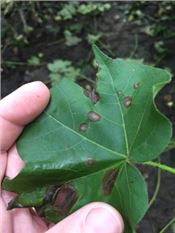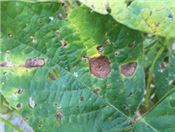Target Spot Management: Thoughts From 2016 Observations
DR. TOM ALLEN
STONEVILLE, MISS.
As the final plans for 2017 are set in place, I continue to receive countless questions regarding target spot of both cotton and soybean. Target spot continues to be one of the hot topics due to the severe occurrence of the disease during 2016. Most of the specific questions dealt with variety selection based on what occurred during 2016. However, the other topic had to do with foliar fungicide application to manage target spot in both cotton and soybean.
The biggest driving factor for the severe, widespread development of target spot in both cotton and soybean during the 2016 season was the environment that occurred during specific growth stages. The two to three weeks of extremely wet, overcast, humid weather in late July through early August, was one of the most important issues and clearly had a tremendous amount to do with the widespread occurrence of target spot in some areas that do not traditionally deal with this particular disease. In general, target spot is one of the more commonly occurring foliar disease in soybean fields throughout Mississippi. In MS, target spot has been a rarer occurrence in cotton fields. However, over the past few years, the amount of information related to target spot in cotton has increased in the farm press or other outlets on the internet. However, be mindful that the southeastern U.S. (more specifically south AL and GA) have a completely different cotton production system and tend to plant on a narrower row spacing (36”) and in most irrigated situations overhead irrigation is the method of choice. Therefore, information from south AL and GA may not be applicable to our cotton production system.
Scenarios regarding the observation and management of target spot situation during 2017 in either cotton or soybean are outlined below:
1. Should the environment not be conducive for the development of target spot the disease will NOT be as severe as was observed during 2016. The conversation about target spot could almost stop here.
2. Foliar fungicides are not a silver bullet for managing target spot.
3. In cotton production systems, data sets from a three year study looking at automatic fungicide applications to manage target spot made based on growth stage timing suggest fungicide applications are only effective 20 percent of the time at protecting yield. At present, data are not available for soybean.
4. Observationally, attempting to manage a disease such as target spot with a fungicide can provide some confusing results. A fungicide will not completely prevent the disease from occurring in either cotton or soybean (more on this in a future post). In addition, based on observations over the past two seasons in both cotton and soybean, severe defoliation can still result even following a fungicide application due to:
• Environment in the lower canopy
• Canopy penetration of the at the time of application
• To a much less degree fungicide product of choice
• Reduced efficacy of the strobilurin (quinone outside inhibitor (QoI)) class of fungicides due to resistance within the target spot organism from soybean systems.
5. Most commercially available cotton and soybean varieties appear to have good tolerance (that may approach resistance) to target spot. But, with that in mind, and certainly in soybean situations there are some extremely susceptible varieties that are commercially available. However, given a conducive environment for prolonged periods of time during important developmental crop growth stages can observationally make it difficult to determine how a fungicide may reduce disease and protect yield.
6. In cotton production systems, managing the proper application of nitrogen (DO NOT OVERFERTILIZE) and reducing cotton growth through the proper use of PGRs to limit rank growth of cotton are more important than the use of an automatic fungicide application when it comes to preventing losses associated with target spot.
7. Fungicides protect against yield losses as a result of foliar disease. Fungicides do not make yield unless a good potential is already present. ∆
DR. TOM ALLEN: Extension Plant Pathologist, Mississippi State University

Target spot of cotton was one of the primary foliar
diseases that occurred in the MS cotton production
system during 2016 as a
result of the environment.

Normal lesion symptom associated with soybean target spot.
The lesion type is similar on target spot
infected cotton leaves.